Breathing and Exchange of Gases
Table of Content
- What is Breathing and Respiration?
- Respiratory organs
- Human Respiratory System
- Mechanism of Breathing
- Respiratory volumes and capacities
- Exchange of gases
- Transport of gases
- Regulation of Respiration
What is Breathing and Respiration?
Breathing is the process of taking in oxygen and giving out carbon-dioxide. Respiration is a catabolic process of breakdown of energy rich molecules to produce energy needed for the survival of the organism.
Respiratory organs
Different organisms have different respiratory organs depending upon the habitat and level of organization.
Earthworm has moist skin that participates in respiration. This type of respiration is known as Cutaneous Respiration. Insects have tracheal tubes that are respiratory in function. Aquatic animals have gills as respiratory organs. Higher animals have lungs for respiration, including human beings.
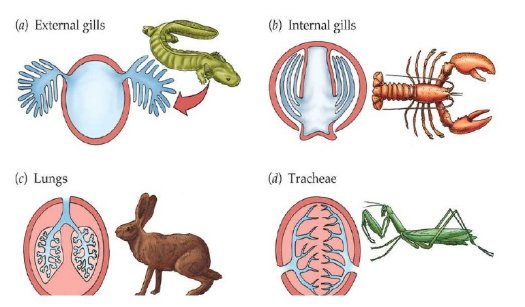
Fig. 1. Different respiratory organs
Human Respiratory System
Humans have a pair of nostrils which leads into the nasal passage. Nasal chamber then leads to pharynx which is common passage for food as well as air. The pharynx opens through the larynx region into the trachea. Larynx is a sound box which helps in sound production. During eating larynx is covered by a flap known as Epiglottis to prevent the entry of the food into the larynx. Trachea is straight tube that divides into left and right primary bronchi. Primary bronchi further divide into secondary and tertiary bronchi and bronchioles. Each terminal bronchioles give rise thin, vascularized bag-like structure known as Alveoli.
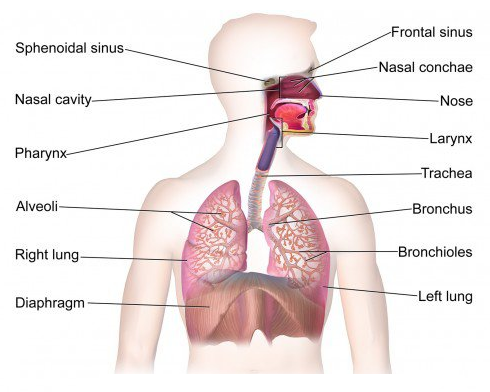
Fig. 2. Human respiratory system
Humans have pair of lungs that are covered by a membrane known as Pleural Membrane. Between the outer and the inner pleural membrane is pleural fluid that prevents friction on the lung surface.
Respiration involves following steps:
- Pulmonary ventilation which involves taking in atmospheric air and releasing carbon-dioxide rich air.
- Diffusion of oxygen and carbon-dioxide across the alveolar membrane.
- Transport of gases by the blood.
- Diffusion of O2 and CO2 between blood and tissues.
- Utilization of oxygen by the cells for catabolic reactions and release of carbon-dioxide.
Mechanism of Breathing
Breathing involves two processes- Inspiration and Expiration.
Inspiration:
- Process of taking atmospheric air in is known as Inspiration.
- It is an active process.
- Pressure inside the lungs is less than the atmospheric pressure.
- Contraction of diaphragm increases the volume of the thoracic cavity.
- External inter-coastal muscles also contract which raises the ribs to increase the volume of thoracic cavity.

Fig. 3. Mechanism of breathing
Expiration:
- Process of giving out carbon-dioxide is known as Expiration.
- It is a passive process.
- Pressure inside the lungs is more than the atmospheric pressure.
- Relaxation of diaphragm decreases the volume of the thoracic cavity.
- External inter-coastal muscles relax which lowers the ribs to decrease the volume of the thoracic cavity.
Respiratory volumes and capacities
Tidal Volume (TV) is the volume of air that is inspired or expired during normal respiration. It is approximately 500 ml for healthy person.
Inspiratory Reserve Volume (IRV) is the additional air a person can inspire after forceful inspiration. It is about 2500 ml to 3000 ml.
Expiratory Reserve Volume (ERV) is the additional air a person can expire after forceful expiration. It is about 1000 ml to 1100 ml.
Residual Volume (RV) is the volume of air left in the lungs after forceful expiration. It is about 1100 ml to 1200 ml.
Inspiratory Capacity (IC) is the volume of air a person can inspire after normal expiration. Tidal volume and inspiratory reserve volume together forms the inspiratory capacity.
Expiratory Capacity (EC) is the volume of air a person can expire after normal inspiration. Tidal volume and expiratory reserve volume forms the expiratory capacity.
Functional Residual Capacity (FRC) includes expiratory reserve volume and residual volume.
Vital Capacity is the volume of air a person can breathe after forceful expiration.
Total lung capacity includes RV, ERV, TV and IRV.
Exchange of gases
Exchange of gases occurs in alveoli. Exchange of gases occurs by diffusion based on pressure or concentration gradient. Two important parameters that affects the rate of diffusion are – solubility of gases and thickness of membrane.
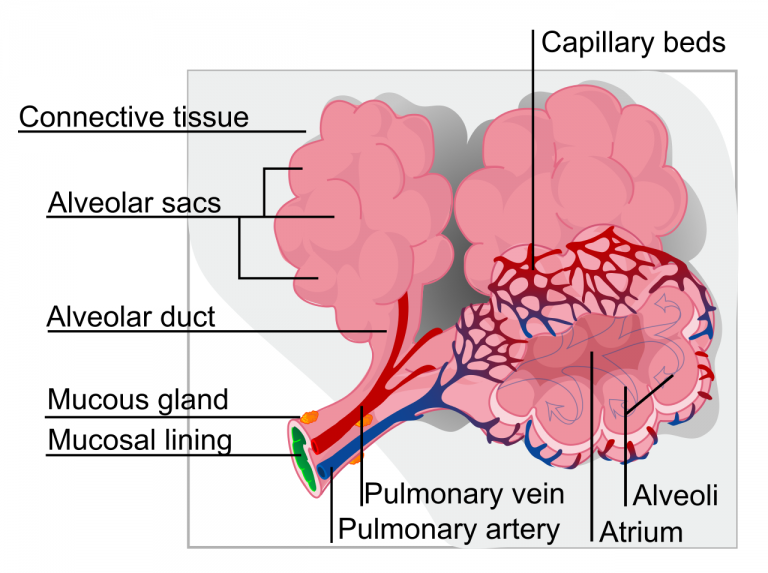
Fig. 4. Structure of alveoli
Pressure contributed by each gas in a mixture of gas is known as partial pressure. Partial pressure of oxygen and carbon-dioxide is represented by pO2 and pCO2 respectively.
The partial pressure of oxygen in alveoli is 104 mmHg whereas in blood is 40 mmHg. Similarly, the partial pressure of carbon-dioxide is 40 mmHg in alveoli and 45 mmHg in blood. This creates a concentration gradient between the blood and the alveoli. The diffusion membrane is made up of 3 layers – the thin squamous epithelium of alveoli, the endothelium of alveolar capillaries and the basement substance in between them.
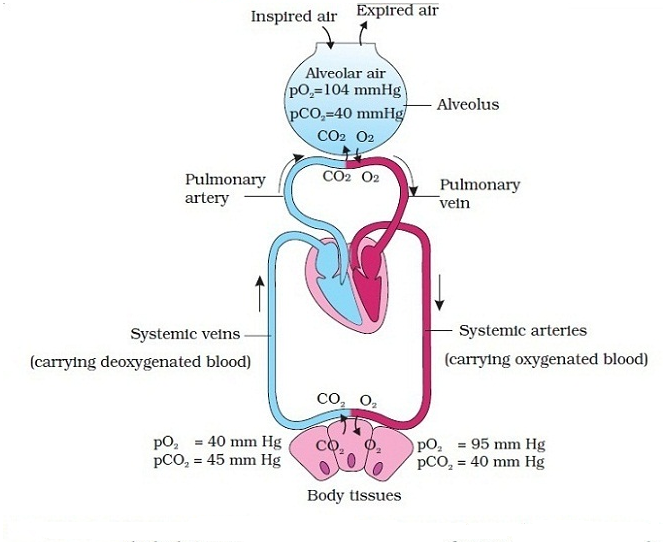
Fig. 5. Exchange of gases
Transport of gases/how oxygen and carbon-dioxide transported in blood?
The transport of oxygen and carbon-dioxide occurs via blood. About 97% of transport of oxygen occurs by blood. And remaining 3% is transported by plasma. Similarly, 70% of carbon-dioxide is transported in the form of bicarbonate. Around 25% is transported via red blood cells. Around 7% is transported in dissolved state via plasma.
Transport of oxygen
Red blood cells contain iron containing red colored pigment known as Hemoglobin. Hemoglobin binds oxygen in a reversible manner to form oxy-hemoglobin. Single hemoglobin molecule can bind 4 oxygen molecules. Partial pressure of oxygen determines the binding of oxygen with hemoglobin. When percent saturation of hemoglobin is plotted against partial pressure of oxygen, a sigmoid curve is obtained. This is known as Oxygen Dissociation curve. High partial pressure of oxygen, low partial pressure of carbon-dioxide, low temperature promotes oxy-hemoglobin formation whereas low partial pressure of oxygen, high partial pressure of carbon-dioxide in tissues promotes dissociation of oxygen from hemoglobin.
So, oxygen binds to hemoglobin in lungs and gets dissociated in tissues.
Transport of carbon-dioxide
About 20-25% of carbon-dioxide is transported in the form of carbamino-hemoglobin. This occurs when partial pressure of carbon-dioxide is high is tissues. The dissociation of carbon-dioxide from hemoglobin occurs in alveoli where partial pressure of carbon-dioxide is low. Red blood cells contain a very important enzyme known as Carbonic Anhydrase. The following reactions occurs in presence of carbonic anhydrase:
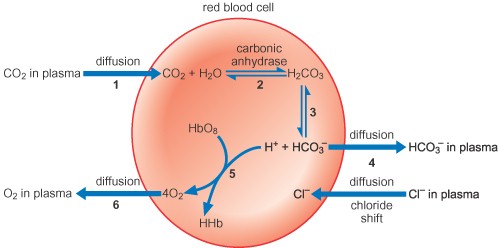
Fig. 6. Transport of carbon-dioxide
Regulation of Respiration
Neural system regulates the respiration. Respiratory control is located in medulla region of the brain. Another center that controls the respiration is known as Pneumotaxic center located in pons.
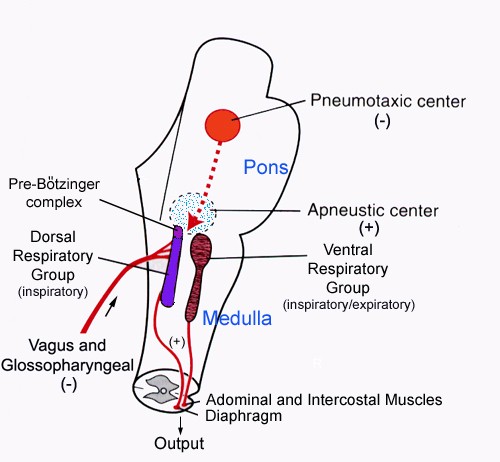
Fig. 7. Regulation of respiration